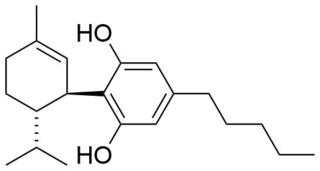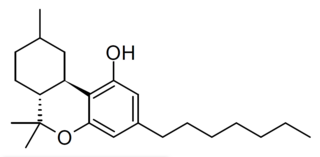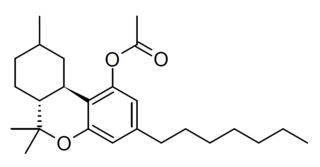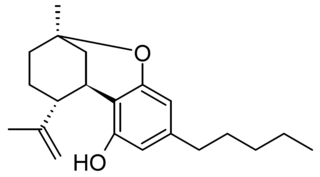
THC-O-acetate is the acetate ester of THC. The term THC-O-acetate and its variations are commonly used for two types of the substance, dependent on which cannabinoid it is synthesized from. The difference between Δ8-THC and Δ9-THC is bond placement on the cyclohexene ring.

AB-FUBINACA (AMB-FUBINACA) is a psychoactive drug that acts as a potent agonist for the cannabinoid receptors, with Ki values of 0.9 nM at CB1 and 23.2 nM at CB2 and EC50 values of 1.8 nM at CB1 and 3.2 nM at CB2. It was originally developed by Pfizer in 2009 as an analgesic medication but was never pursued for human use. In 2012, it was discovered as an ingredient in synthetic cannabinoid blends in Japan, along with a related compound AB-PINACA, which had not previously been reported.

5F-ADB (also known as MDMB-5F-PINACA and 5F-MDMB-PINACA) is an indazole-based synthetic cannabinoid from the indazole-3-carboxamide family, which has been used as an active ingredient in synthetic cannabis products and has been sold online as a designer drug. 5F-ADB is a potent agonist of the CB1 receptor, though it is unclear whether it is selective for this target. 5F-ADB was first identified in November 2014 from post-mortem samples taken from an individual who had died after using a product containing this substance. Subsequent testing identified 5F-ADB to have been present in a total of ten people who had died from unexplained drug overdoses in Japan between September 2014 and December 2014. 5F-ADB is believed to be extremely potent based on the very low levels detected in tissue samples, and appears to be significantly more toxic than earlier synthetic cannabinoid drugs that had previously been sold.

ADB-CHMINACA (also known as ADMB-CHMINACA and MAB-CHMINACA) is an indazole-based synthetic cannabinoid. It is a potent agonist of the CB1 receptor with a binding affinity of Ki = 0.289 nM and was originally developed by Pfizer in 2009 as an analgesic medication. It was identified in cannabinoid blends in Japan in early 2015.

MDMB-CHMICA is an indole-based synthetic cannabinoid that is a potent agonist of the CB1 receptor and has been sold online as a designer drug. While MDMB-CHMICA was initially sold under the name "MMB-CHMINACA", the compound corresponding to this code name (i.e. the isopropyl instead of t-butyl analogue of MDMB-CHMINACA) has been identified on the designer drug market in 2015 as AMB-CHMINACA.

5F-APINACA is an indazole-based synthetic cannabinoid that has been sold online as a designer drug. Structurally it closely resembles cannabinoid compounds from patent WO 2003/035005 but with a 5-fluoropentyl chain on the indazole 1-position, and 5F-APINACA falls within the claims of this patent, as despite not being disclosed as an example, it is very similar to the corresponding pentanenitrile and 4-chlorobutyl compounds which are claimed as examples 3 and 4.

MDMB-CHMINACA (also known as MDMB(N)-CHM) is an indazole-based synthetic cannabinoid that acts as a potent agonist of the CB1 receptor, and has been sold online as a designer drug. It was invented by Pfizer in 2008, and is one of the most potent cannabinoid agonists known, with a binding affinity of 0.0944 nM at CB1, and an EC50 of 0.330 nM. It is closely related to MDMB-FUBINACA, which caused at least 1000 hospitalizations and 40 deaths in Russia as consequence of intoxication.

CUMYL-PEGACLONE (SGT-151) is a gamma-carboline based synthetic cannabinoid that has been sold as a designer drug. The gamma-carboline core structure seen in CUMYL-PEGACLONE had not previously been encountered in a designer cannabinoid, though it is similar in structure to other gamma-carboline cannabinoids disclosed by Bristol-Myers Squibb in 2001.

8,9-Dihydrocannabidiol is a synthetic cannabinoid that is closely related to cannabidiol (CBD) itself. that was first synthesized by Alexander R. Todd in 1940 derived from the catalytic hydrogenation of cannabidiol.

MDMB-4en-PINACA is an indazole-based synthetic cannabinoid that has been sold online as a designer drug. MDMB-4en-PINACA was first identified in Europe in 2017. In 2021, MDMB-4en-PINACA was the most common synthetic cannabinoid identified by the Drug Enforcement Administration in the United States. MDMB-4en-PINACA differs from 5F-MDMB-PINACA due to replacement of 5-fluoropentyl with a pent-4-ene moiety (4-en).

Δ-10-Tetrahydrocannabinol is a positional isomer of tetrahydrocannabinol, discovered in the 1980s. Two enantiomers have been reported in the literature, with the 9-methyl group in either the (R) or (S) conformation; of these, the (R) enantiomer appears to be the more active isomer as well as the double bond in the 10th position instead of the 9th maintaining about 30 to 40 percent the potency of delta-9-THC. Δ10-THC has rarely been reported as a trace component of natural cannabis, though it is thought to be a degradation product similar to cannabinol rather than being produced by the plant directly. However, it is found more commonly as an impurity in synthetic delta-8-THC produced from cannabidiol and can also be synthesized directly from delta-9-THC.

Hexahydrocannabinol (HHC) is a hydrogenated derivative of tetrahydrocannabinol (THC). It is a naturally occurring phytocannabinoid that has rarely been identified as a trace component in Cannabis sativa, but can also be produced synthetically by acid cyclization and hydrogenation of cannabidiol. The synthesis and bioactivity of HHC was first reported in 1940 by Roger Adams.

11-Hydroxyhexahydrocannabinol is an active metabolite of tetrahydrocannabinol (THC) and a metabolite of the trace cannabinoid hexahydrocannabinol (HHC).

MDMB-5Br-INACA is an indazole-3-carboxamide derivative which has been sold as a designer drug. Surprisingly it appears to produce psychoactive activity despite the lack of a "tail" group at the indazole 1-position, but is of relatively low potency and has been encountered being misrepresented as other illicit drugs such as MDMA.

ADB-FUBIATA (AD-18, FUB-ACADB, ADB-FUBIACA) is a synthetic cannabinoid compound first identified in 2021. It is closely related in structure to the older compound ADB-FUBICA but with the amide linker group extended by the addition of a methylene bridge. It started to be sold as an ingedient in grey-market synthetic cannabis blends following the introduction of legislation in China which for the first time introduced general controls on various classes of synthetic cannabinoids, but did not encompass compounds where the linker group had been extended in this fashion. ADB-FUBIATA has many times lower affinity for cannabinoid receptors than ADB-FUBICA with an EC50 of only 635 nM at CB1, but retains full agonist activity at this target, while being practically inactive at CB2.

Hexahydrocannabiphorol is a semi-synthetic cannabinoid derivative which has been marketed since around 2021. It is believed to be made from the hydrogenation of tetrahydrocannabiphorol (THCP). THCP is only reported as a trace component of cannabis in 2019. HHCP was studied by Roger Adams as early as 1942.

Hexahydrocannabihexol (HHCH) is a semi-synthetic cannabinoid derivative. It was first synthesised by Roger Adams in 1942 and found to be more potent than either the pentyl or heptyl homologues, or the unsaturated tetrahydrocannabinol analogue.

HHCP-O-acetate is a semi-synthetic derivative of tetrahydrocannabiphorol (THCP) derived in several steps by hydrogenation to hexahydrocannabiphorol (HHCP) followed by acetylation of the OH group. It has been found as a component of grey-market cannabis products such as e-cigarette liquids and edible gumdrops, and is allegedly a potent and long-lasting psychoactive cannabinoid.

Isotetrahydrocannabinol (iso-THC) is a phytocannabinoid similar in structure to cannabicitran which has been identified as a trace component of Cannabis, but is more commonly found as an impurity in synthetic THC which has been made from cannabidiol, along with other isomers with the double bond in a different position and the saturated dihydro derivative. iso-THC can be described as the upper cyclization product of CBD, while THC is the lower cyclization product of CBD. Its pharmacology has not been studied, though it is commonly found as a trace impurity in commercially marketed Δ8-THC products.

Abeo-HHC acetate is a semi-synthetic derivative of tetrahydrocannabinol, first described in the 1980s. It is synthesised from delta-11-tetrahydrocannabinol, which can be made to undergo a ring expansion reaction via a hydrazone intermediate. It is structurally similar to HHC-acetate except it's substituted with a cycloheptyl ring instead of a methylated cyclohexyl ring.




















